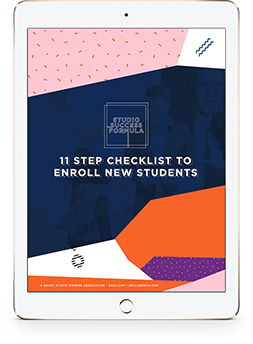Checking emails.
Ugh – the words alone are anxiety-inducing, let alone the actual task of sitting down to watch the hours whizz by while you feel like you’ve done nothing more than label some ‘Spam’ and reply to 46 identical emails asking you about the upcoming rehearsal.
BUT emails are also the main communication artery for your studio in 2017, so while it can and will be an enormous leech on your time and productivity if you don’t handle it well on a day-to-day basis, it’s also a necessity.
The key is finding the right way to handle your emails, which is where our top 6 Inbox Hacks are going to save you time, energy, money (on the wine you’d need to consume while dealing with them all) and most importantly your sanity.
Turn Off Your Emails
Not completely, of course. But it’s time to get onto your smartphone and your tablet and remove those email notifications right away. “Why?” You might ask. “I need 24/7 access to my emails….what if it’s an emergency or a new client”?
Well that’s exactly why – if it is an emergency, you’ve got a phone.
If it’s a new client, an important business partner, a disgruntled parent or an impossible vendor then the worst thing you can do is to respond to their email on the fly without your resources on hand and your mindset in the right place. Instead, schedule 2 or 3 times per day (more if you really need it. Which you don’t) of dedicated email time. You sit at your desk, login and give every email the time they need to reply, file or delete.
The golden rule is this – if you don’t have time to reply or act, then don’t check it until you do.
Share your inbox
Introducing customer service software or a “shared inbox” is one of the best things you can do to streamline, manage and oversee your studio communications and it’s honestly a shock that more studios are not jumping on board. Put simply, here is how a shared inbox works.
Step 1 – Email is received.
“Hi! I’d love to sign up for your Zumba classes – how do I enrol? Also, what is the cost and time of class?
Step 2 – Email is assigned.
Whoever is checking your inbox (which can be multiple people at once) is going to assign this email to one of your shared inbox accounts. Let’s call then Donald, Daisy and Pluto who each have their own account.
Step 3 – You leave a note on the email that is seen only by your team and not the recipient.
“Daisy – please email with timetable, fee schedule and class info” which goes into Daisy’s inbox. As a team member, you can jump into Daisy, Donald and Pluto’s inbox at any time and see which conversations have gone to whom, and how far along in the customer service process they are. And this is all at a glance – no more clicking between ‘drafts’ and ‘sent mail’ folders to find what you’re looking for.
Step 4 – Email is closed
Once the info has been sent by Daisy she can ‘close’ this thread. If the recipient replies it will automatically reopen with all of the previous emails neatly laid out for you to monitor where you are at. You can also check in on all closed emails to see how things have been handled and provide feedback to your team.
To set up a shared inbox you won’t need to change your current address or email provider – simply forward all incoming emails to one of the many services available such as Helpscout, Zendesk or Intercom (to name just a few) and you will never look back.
3/ OHIO
Only
Handle
It
Once
It’s that simple – you need to decide whether you will respond, allocate, file or delete each and every email. Treat each piece like a snail-mail letter arriving in your mailbox – if you don’t feel like responding to a bill immediately, you don’t just put it back in your mailbox do you? No. You pay it, file it, give it to your spouse or (hopefully not) throw it away.
Each email that comes to you should only ever be handled once before taking action and moving on to the next.
Use ALL The Features
You’ve heard of add-ons and extensions with your emails and some of them can be huge timesavers and readily available across a range of email platforms. For example did you know that in a simple GMail account you can:
- Set up emails that come back to you at your preferred time intervals if there is no response – check out boomerang
- Automate replies to deal with the same questions you get day in and day out – see text expander
- Work on your emails even when there is no internet connection – take a look at Gmail offline
- Hit the snooze button, so you can stop being interrupted and have your emails held in 5 minutes or entire days – check out Snooze Your Email
Take some time to search for all the various extensions, add-ons and plug-ins available to you and you are guaranteed to find a goldmine of tools that will increase your productivity
Set yourself up to win
Like all good things, having a healthy and stress-free inbox is going to take some time and effort to set up initially but will pay off in dividends once done well. The simplest way to get started is to sort out your folders and filters. Your folders may include:
- New enquiries
- Trial bookings
- Enrolled students
- Accounts
- Newsletters
- Partners
- Concert/Recital
- Volunteers
- Team
- Social Media
- Events
- Images
- Testimonials
- Feedback
- Personal
- Marketing
- Website
- Community
Once your folders are set up you can start to filter messages by key word, sender or subject to go directly into your folders, or you can manually file them as they arrive. Having a great foundation for your email filing is going to save you so much time and hassle in the life of your studio and should be your first stop in ‘de-cluttering’ your inbox.
Outsource
Once you finally have your head around all the possibilities and newly organized goodness of your inbox, it’s time to say goodbye. By taking on all of the above tips you are in the perfect place to hand over email responsibility to your team or outsource to a virtual assistant. With your new shared inbox in place you can check in (5 mins max) daily to oversee before sinking your teeth into opportunities that will truly fill your cup.
For more tips on growing and managing your studio, we’d love you to join us inside the Dance Studio Owners Association today.
SHARE THE LOVE
[Sassy_Social_Share]

YOUR 7 DAY GUIDE TO ATTRACTING STUDENTS

Increase Profits
Through Introducing Additional Revenue Stream





